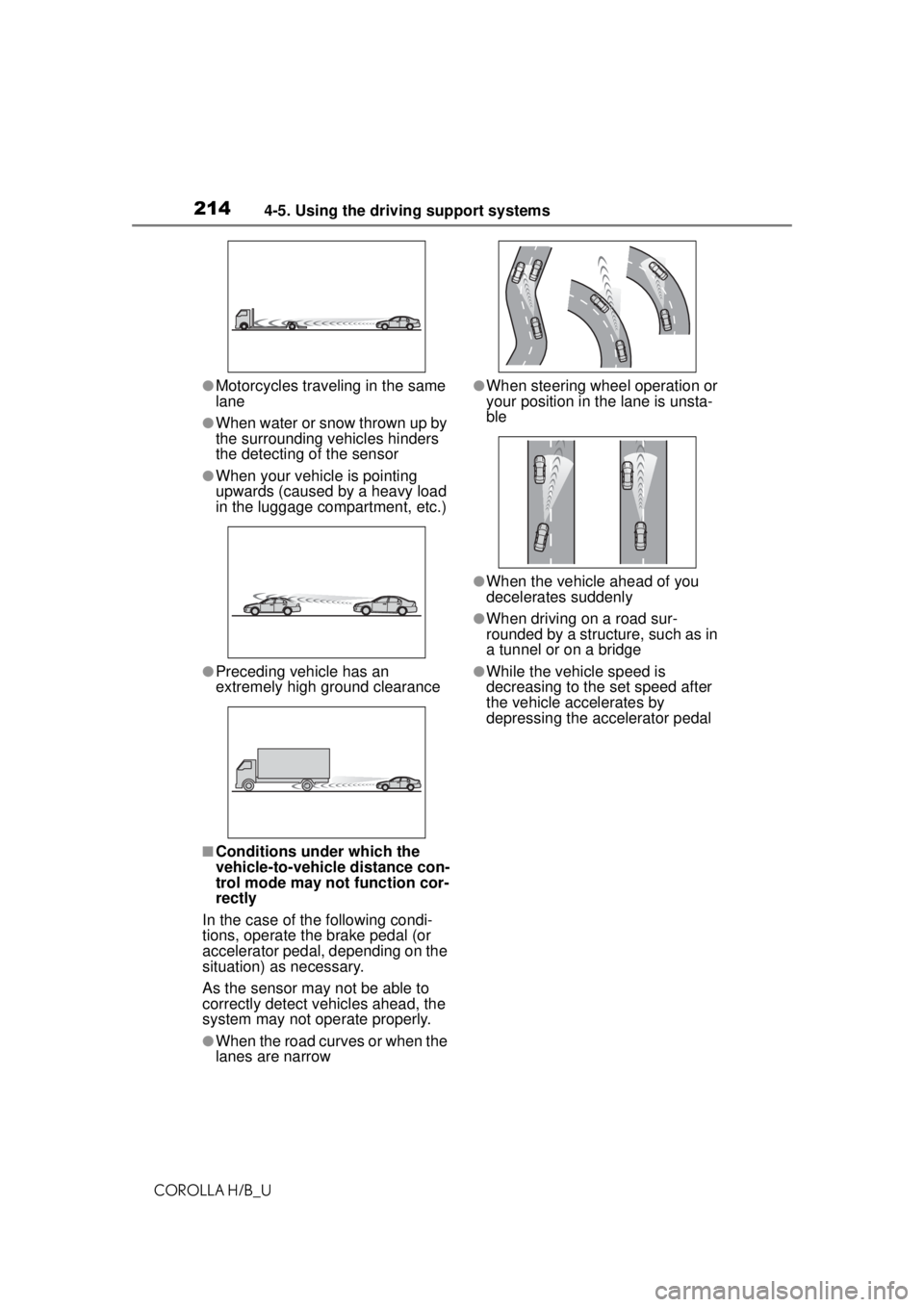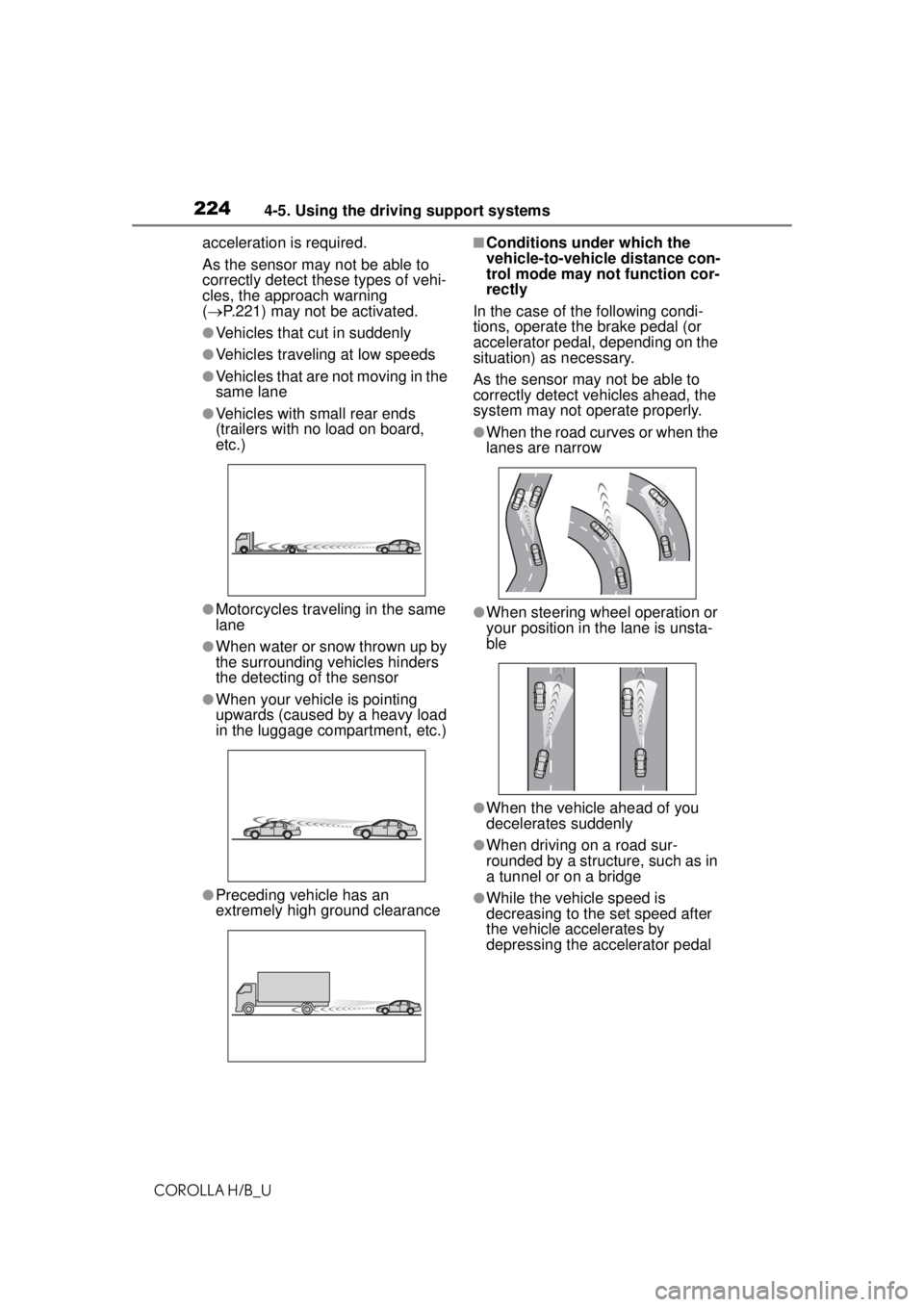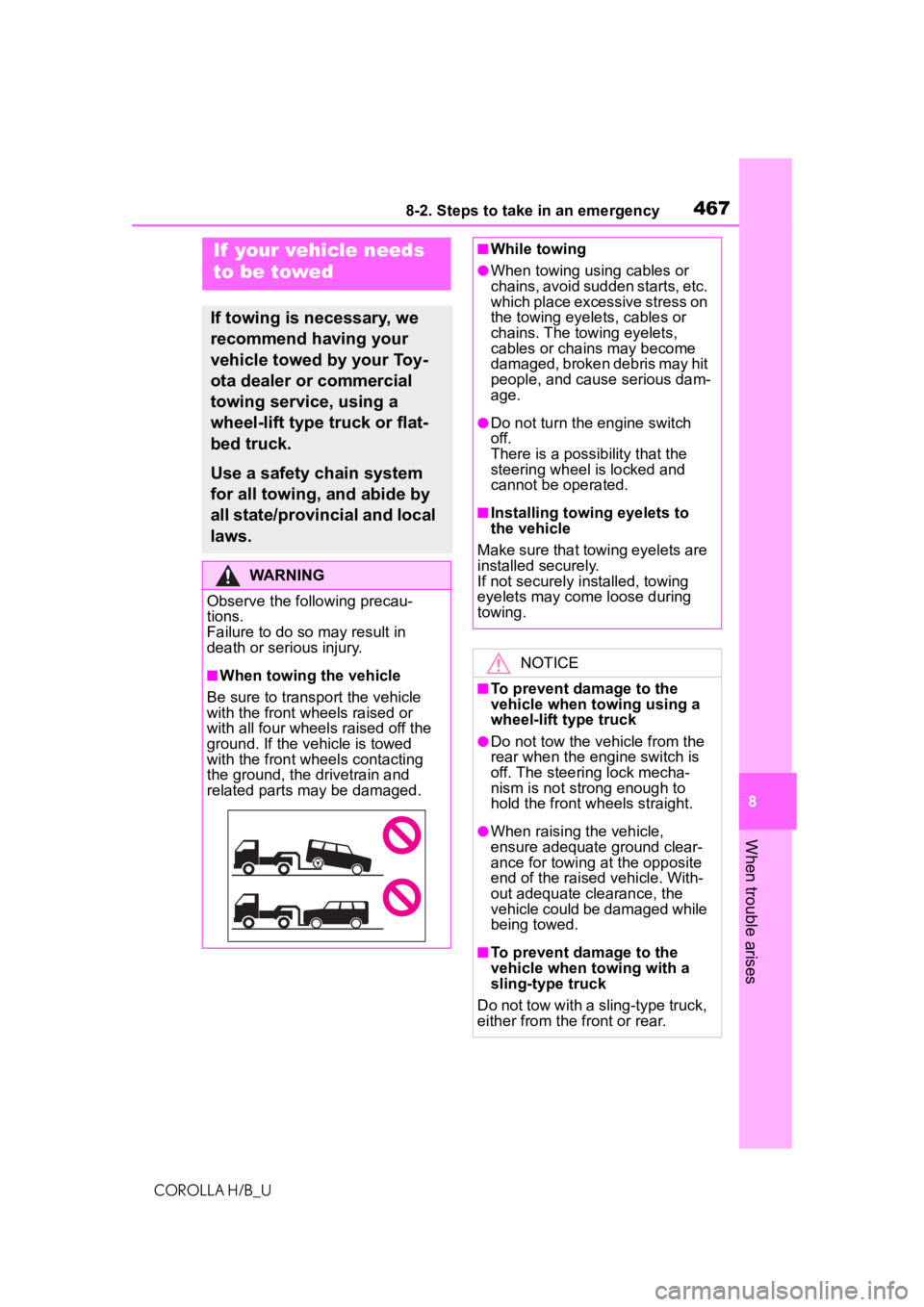ground clearance TOYOTA COROLLA HATCHBACK 2021 Owners Manual (in English)
[x] Cancel search | Manufacturer: TOYOTA, Model Year: 2021, Model line: COROLLA HATCHBACK, Model: TOYOTA COROLLA HATCHBACK 2021Pages: 576, PDF Size: 12.73 MB
Page 184 of 576

1844-5. Using the driving support systems
COROLLA H/B_Uswerving, acceleration or deceler-
ation)
• When your vehicle approaches a
detectable object rapidly
• When a detectable object is not directly in front of your vehicle
• When a detectable object is near a wall, fence, guardrail, manhole
cover, vehicle, steel plate on the
road, etc.
• When a detectable object is under
a structure
• When part of a detectable object is hidden by an object, such as
large baggage, an umbrella, or
guardrail
• When multiple de tectable objects
are close together
• If the sun or other light is shining directly on a detectable object
• When a detectable object is a shade of white and looks
extremely bright
• When a detectable object appears to be nearly the same color or
brightness as its surroundings
• If a detectable object cuts or sud- denly emerges in front of your
vehicle
• When the front of your vehicle is hit by water, snow, dust, etc.
• When a very bright light ahead,
such as the sun or the headlights
of oncoming traffic, shines directly
into the front camera
• When approaching the side or front of a vehicle ahead
• If a vehicle ahead is a motorcycle
• If a vehicle ahead is narrow, such as a personal mobility vehicle
• If a preceding vehicle has a small rear end, such as an unloaded
truck
• If a preceding vehicle has a low rear end, such as a low bed trailer
• If a vehicle ahead has extremely high ground clearance
• If a vehicle ahead is carrying a load which protrudes past its rear
bumper
• If a vehicle ahead is irregularly
shaped, such as a tractor or side
car
• If a vehicle ahead is a child sized
bicycle, a bicycle that is carrying a
large load, a bicycle ridden by
more than one person, or a
uniquely shaped bicycle (bicycle
with a child seat, tandem bicycle,
etc.)
• If a pedestrian/or the riding height of a bicyclist ahead is shorter than
approximately 3.2 ft. (1 m) or taller
than approximately 6.5 ft. (2 m)
• If a pedestrian/bicyclist is wearing oversized clothing (a rain coat,
long skirt, etc.), making their sil-
houette obscure
• If a pedestrian is bending forward
or squatting or bicyclist is bending
forward
• If a pedestrian/bicyclist is moving
fast
• If a pedestrian is pushing a stroller, wheelchair, bicycle or
other vehicle
• When driving in inclement weather such as heavy rain, fog, snow or a
sandstorm
Page 214 of 576

2144-5. Using the driving support systems
COROLLA H/B_U
â—ŹMotorcycles traveling in the same
lane
â—ŹWhen water or snow thrown up by
the surrounding vehicles hinders
the detecting of the sensor
â—ŹWhen your vehicle is pointing
upwards (caused by a heavy load
in the luggage compartment, etc.)
â—ŹPreceding vehicle has an
extremely high ground clearance
â– Conditions under which the
vehicle-to-vehicle distance con-
trol mode may not function cor-
rectly
In the case of the following condi-
tions, operate the brake pedal (or
accelerator pedal, depending on the
situation) as necessary.
As the sensor may not be able to
correctly detect vehicles ahead, the
system may not operate properly.
â—ŹWhen the road curves or when the
lanes are narrow
â—ŹWhen steering wheel operation or
your position in the lane is unsta-
ble
â—ŹWhen the vehicle ahead of you
decelerates suddenly
â—ŹWhen driving on a road sur-
rounded by a structure, such as in
a tunnel or on a bridge
â—ŹWhile the vehicle speed is
decreasing to the set speed after
the vehicle accelerates by
depressing the accelerator pedal
Page 224 of 576

2244-5. Using the driving support systems
COROLLA H/B_Uacceleration is required.
As the sensor may not be able to
correctly detect these types of vehi-
cles, the approach warning
(
ď‚® P.221) may not be activated.
â—ŹVehicles that cut in suddenly
â—ŹVehicles traveling at low speeds
â—ŹVehicles that are not moving in the
same lane
â—ŹVehicles with small rear ends
(trailers with no load on board,
etc.)
â—ŹMotorcycles traveling in the same
lane
â—ŹWhen water or snow thrown up by
the surrounding vehicles hinders
the detecting of the sensor
â—ŹWhen your vehicle is pointing
upwards (caused by a heavy load
in the luggage compartment, etc.)
â—ŹPreceding vehicle has an
extremely high ground clearance
â– Conditions under which the
vehicle-to-vehicle distance con-
trol mode may not function cor-
rectly
In the case of the following condi-
tions, operate the brake pedal (or
accelerator pedal, depending on the
situation) as necessary.
As the sensor may not be able to
correctly detect vehicles ahead, the
system may not operate properly.
â—ŹWhen the road curves or when the
lanes are narrow
â—ŹWhen steering wheel operation or
your position in the lane is unsta-
ble
â—ŹWhen the vehicle ahead of you
decelerates suddenly
â—ŹWhen driving on a road sur-
rounded by a structure, such as in
a tunnel or on a bridge
â—ŹWhile the vehicle speed is
decreasing to the set speed after
the vehicle accelerates by
depressing the accelerator pedal
Page 467 of 576

4678-2. Steps to take in an emergency
COROLLA H/B_U
8
When trouble arises
8-2.Steps to take in an emergency
If your vehicle needs
to be towed
If towing is necessary, we
recommend having your
vehicle towed by your Toy-
ota dealer or commercial
towing service, using a
wheel-lift type truck or flat-
bed truck.
Use a safety chain system
for all towing, and abide by
all state/provincial and local
laws.
WARNING
Observe the following precau-
tions.
Failure to do so may result in
death or serious injury.
â– When towing the vehicle
Be sure to transport the vehicle
with the front wheels raised or
with all four wheels raised off the
ground. If the vehicle is towed
with the front wheels contacting
the ground, the drivetrain and
related parts may be damaged.
â– While towing
â—ŹWhen towing using cables or
chains, avoid sudden starts, etc.
which place excessive stress on
the towing eyelets, cables or
chains. The towing eyelets,
cables or chains may become
damaged, broken debris may hit
people, and cause serious dam-
age.
â—ŹDo not turn the engine switch
off.
There is a possibility that the
steering wheel is locked and
cannot be operated.
â– Installing towing eyelets to
the vehicle
Make sure that towing eyelets are
installed securely.
If not securely installed, towing
eyelets may come loose during
towing.
NOTICE
â– To prevent damage to the
vehicle when towing using a
wheel-lift type truck
â—ŹDo not tow the vehicle from the
rear when the engine switch is
off. The steering lock mecha-
nism is not strong enough to
hold the front wheels straight.
â—ŹWhen raising the vehicle,
ensure adequate ground clear-
ance for towing at the opposite
end of the raised vehicle. With-
out adequate clearance, the
vehicle could be damaged while
being towed.
â– To prevent damage to the
vehicle when towing with a
sling-type truck
Do not tow with a sling-type truck,
either from the front or rear.